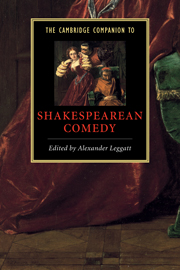3 - Italian stories on the stage
from Part 1 - Shakespeare and comic tradition
Published online by Cambridge University Press: 28 May 2006
Summary
Stephen Gosson might treble and intensify his famous antitheatrical malediction could he know what a cliché of theatre history one sentence of it has become:
I have seen it that the Palace of Pleasure, the Golden Ass, the Ethiopian History, Amadis of France, the Round Table, bawdy comedies in Latin, French, Italian and Spanish have been thoroughly ransacked to furnish the playhouses in London.
It is time to take Gosson seriously, to identify Shakespeare as one of the ransackers and to treat his Italian stories as a chapter in the history of ransacking, which also entails treating ransacking itself as a first premise of Renaissance dramaturgy.
Ever since Chaucer’s Clerk and Franklin told tales from the Decameron, English literature has borne traces of Italian stories, though to call them “Italian” is to dismiss their remote origins, in many cases lost in the distance of antiquity and Indo-European folklore. It was the Renaissance versions, however, the “mery bookes of Italie” that delighted sixteenth-century English readers and, according to Roger Ascham, undermined their faith and morals. Playwrights in those times before copyright laws were under no pressure to invent original stories and instead valued new presentation of old material. Italy was the contemporary crucible of dramatic theory and Tasso, foremost among theorists, wrote that originality in dramatic composition should consist in form rather than in matter.
- Type
- Chapter
- Information
- The Cambridge Companion to Shakespearean Comedy , pp. 32 - 46Publisher: Cambridge University PressPrint publication year: 2001



